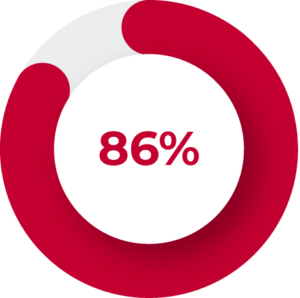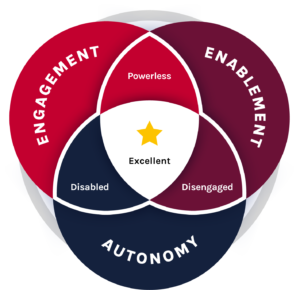Employee Experience. It’s a phrase every federal leader should know and have a laser focus on. Great Employee Experience (EX) is the secret ingredient for great organizational results. Below, Yasmeen Burns explains why EX matters now more than ever, provides insight into what EX is and isn’t, and offers tips for today’s leaders.
Why EX Matters More than Ever
In a post-pandemic world, the Employee Experience has become increasingly pivotal for federal leaders. Ignoring this challenge could lead to substantial costs and missed opportunities. Here’s why:

- Research indicates that engaged employees are 17% more productive than their less engaged counterparts. Moreover, organizations with high employee engagement experience 41% lower absenteeism and 59% lower turnover rates. These figures underscore the financial impact of employee dissatisfaction and disengagement on organizational effectiveness and operational costs.

- The competitive landscape for talent is intensifying. Past HR research from Gartner found that 86% of HR leaders believe the future of work will be defined by flexible work policies and a strong employee value proposition. Federal agencies must adapt to these expectations to attract and retain skilled professionals, as the quality of the workplace experience significantly influences recruitment outcomes.

- The mental health implications are profound. The World Health Organization highlights that depression and anxiety cost the global economy an estimated $1 trillion per year in lost productivity. Neglecting employee well-being may lead to increased healthcare costs and decreased organizational resilience, compounding the financial repercussions.
It all adds up to one key takeaway: Federal leaders must prioritize initiatives that enhance the Employee Experience to mitigate these risks and harness the benefits of a motivated workforce. Investing in workplace culture, flexibility, and mental health support is not just an ethical imperative but a strategic necessity for long-term organizational success.
Defining Employee Experience
At The Clearing, we consider Employee Experience holistically. EX encompasses the totality of an employee’s journey within an organization, including their interactions, perceptions, and feelings about their work environment, leadership, and overall organizational culture.
You may ask, “How does Employee Experience differ from Employee Engagement?” Employee Experience is a broader concept than Employee Engagement. While engagement focuses on the emotional commitment an employee has towards their organization and their willingness to go above and beyond, EX includes every touchpoint an employee has with the organization—from recruitment and onboarding to daily interactions, career development, and even their exit. Employee Engagement is a critical component of EX but only one part of the overall experience.
Prioritizing & Enhancing an EX-centric Culture

Creating a culture that prioritizes and enhances the Employee Experience is critical for any organization, especially within the federal sector, where employee satisfaction directly impacts public service quality.
At The Clearing, our cadre of EX experts utilize our Employee Experience Improvement model, adapted from Itam & Ghosh, 2020, to help federal agencies of all types create a better experience and improve organizational outcomes. The model offers a structured approach to EX work and focuses on three key pillars: Engagement, Enablement, and Autonomy.
Here’s how leaders can leverage each pillar to foster a positive Employee Experience.
Engagement centers on employees’ emotional connection to their organization, including their commitment to its mission and goals. It encompasses their perceptions of organizational culture, leadership effectiveness, and job satisfaction.
![]()
- Promote Open Communication: Create channels for regular, transparent communication between leadership and employees. This includes town hall meetings, suggestion boxes, and open-door policies.
- Recognize and Reward Contributions: Implement recognition programs that celebrate employee achievements, fostering a sense of appreciation and belonging.
- Foster Organizational Culture: Develop a strong, inclusive organizational culture that aligns with the values and mission of the agency. Engage employees in culture-building activities and solicit their input on cultural initiatives.
![]()
The Clearing helped one major federal agency use comprehensive employee feedback mechanisms to enhance engagement, resulting in improved job satisfaction and retention rates.
Enablement involves providing employees with the necessary resources and support to perform their jobs effectively. This includes access to training, development opportunities, and essential tools and technology.
![]()
- Invest in Training and Development: Offer continuous learning opportunities tailored to different roles. This includes technical training, leadership development, and soft skills training.
- Ensure Access to Tools and Technology: Equip employees with up-to-date technology and tools that enhance productivity and efficiency. Regularly assess and upgrade these resources to meet evolving needs.
- Supportive Management: Train managers to provide the necessary support and resources for their teams. This includes regular check-ins, mentorship programs, and providing clear guidance.
![]()
The Clearing worked with a federal leader to help their organization continuously leverage employee feedback to enhance enablement, ensuring staff have the necessary resources and support to excel in their roles.
Autonomy refers to the degree of independence employees have in their roles, including their ability to problem-solve, take risks, voice concerns, and influence decision-making processes.
![]()
- Empower Decision-Making: Encourage employees to take ownership of their work and make decisions related to their tasks. This builds trust and fosters a sense of responsibility.
- Encourage Innovation and Risk-Taking: Create a safe environment where employees feel comfortable proposing new ideas and taking calculated risks without fear of negative repercussions.
- Solicit and Act on Employee Feedback: Regularly gather input from employees on their autonomy and make necessary adjustments to policies and procedures to enhance their decision-making capabilities.
![]()
The Clearing’s EX experts assisted a large federal agency in implementing initiatives to promote autonomy among its employees, allowing for greater innovation and efficiency in their work.
How The Clearing Can Help You Improve EX
As discussed above, in the wake of the pandemic federal agencies face unique challenges in adapting to new working norms while addressing evolving Employee Experience needs. This makes cultivating a positive and engaging Employee Experience a strategic imperative for driving organizational success and enhancing public service delivery.
If you observe flagging FEVS scores, drops in organizational performance, or increased customer complaints, examining your EX is a great place to start when looking for solutions. However, knowing where to start can be difficult, making engaging the right partner critical. That’s where The Clearing’s EX experts and E3 model come in, offering industry-leading know-how and a robust framework to help you achieve your goals by focusing on engagement, enablement, and autonomy – ultimately fostering a thriving and resilient workforce. Reach out when you’re ready – we are always ready to chat.






 The Clearing’s Employee Experience
Improvement model, adapted from Itam
& Ghosh, 2020, focuses on three objectives:
The Clearing’s Employee Experience
Improvement model, adapted from Itam
& Ghosh, 2020, focuses on three objectives: 














